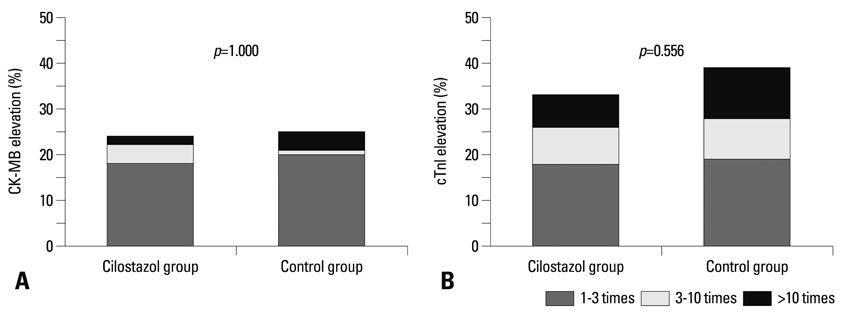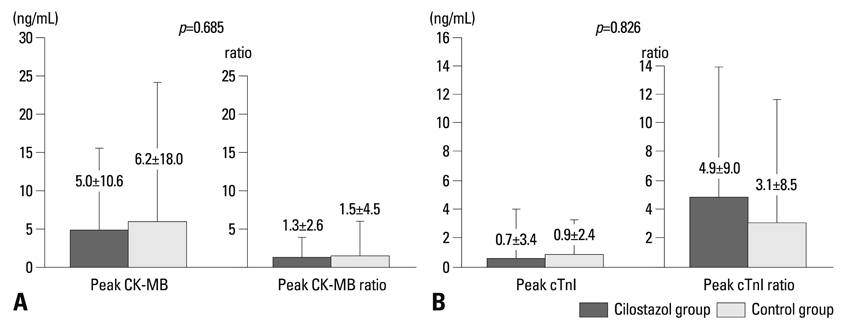Yonsei Med J.
2011 Sep;52(5):717-726. 10.3349/ymj.2011.52.5.717.
A Randomized Study Assessing the Effects of Pretreatment with Cilostazol on Periprocedural Myonecrosis after Percutaneous Coronary Intervention
- Affiliations
-
- 1Cardiology Division, Cardiovascular Center of National Health Insurance Corporation Ilsan Hospital, Goyang, Korea. kbk2565@freechal.com
- 2Division of Cardiology, Yonsei Cardiovascular Center, Yonsei University College of Medicine, Seoul, Korea.
- KMID: 1108062
- DOI: http://doi.org/10.3349/ymj.2011.52.5.717
Abstract
- PURPOSE
It is unknown whether cilostazol pretreatment reduces postprocedural myonecrosis (PPMN). Cilostazol pretreatment reduces PPMN after percutaneous coronary intervention (PCI).
MATERIALS AND METHODS
A total of 120 patients with stable angina scheduled for elective PCI were randomly assigned to a 7-day pretreatment with Cilostazol (200 mg/day) or to a control group. Creatine kinase-MB (CK-MB) and cardiac troponin I (cTnI) levels were measured at baseline and at 6 and 24 hours after PCI. The primary end-point was the occurrence of PPMN, defined as any CK-MB elevation above the upper normal limit (UNL). Aspirin and clopidogrel were co-administered for 7 days before PCI, and resistance to these agents was then assayed using the VerifyNow System.
RESULTS
There was no difference in baseline characteristics between the final analyzable cilostazol (n=54) and the control group (n=56). Despite a significantly greater % inhibition of clopidogrel in the cilostazol group (39+/-23% versus 25+/-22%, p=0.003), the incidence of PPMN was similar between the cilostazol group (24%) and the control group (25%, p=1.000). The rate of CK-MB elevation at > or =3 times UNL was also similar between the two groups (6% versus 5%, p=0.583). The incidence of cTnI increase over the UNL or to 3 times the UNL was not different between the two groups. There was no significant difference in terms of the rate of adverse events during follow-up, although the cilostazol group showed a tendency to have a slightly higher incidence of entry site hematoma.
CONCLUSION
This trial demonstrated that adjunctive cilostazol pretreatment might not significantly reduce PPMN after elective PCI in patients with stable angina.
Keyword
MeSH Terms
-
Aged
Angina, Stable/drug therapy/enzymology/therapy
Angioplasty, Balloon, Coronary/*adverse effects
Creatine Kinase, MB Form/blood
Female
Heart Injuries/etiology/prevention & control
Humans
Male
Middle Aged
Myocardium/pathology
Necrosis
Phosphodiesterase 3 Inhibitors/*administration & dosage
Prospective Studies
Tetrazoles/*administration & dosage
Figure
Reference
-
1. Nallamothu BK, Bates ER. Periprocedural myocardial infarction and mortality: causality versus association. J Am Coll Cardiol. 2003. 42:1412–1414.2. Pasceri V, Patti G, Nusca A, Pristipino C, Richichi G, Di Sciascio G. ARMYDA Investigators. Randomized trial of atorvastatin for reduction of myocardial damage during coronary intervention: results from the ARMYDA (Atorvastatin for Reduction of MYocardial Damage during Angioplasty) study. Circulation. 2004. 110:674–678.
Article3. Bhatt DL, Topol EJ. Does creatinine kinase-MB elevation after percutaneous coronary intervention predict outcomes in 2005? Periprocedural cardiac enzyme elevation predicts adverse outcomes. Circulation. 2005. 112:906–915.
Article4. Cavallini C, Savonitto S, Violini R, Arraiz G, Plebani M, Olivari Z, et al. Impact of the elevation of biochemical markers of myocardial damage on long-term mortality after percutaneous coronary intervention: results of the CK-MB and PCI study. Eur Heart J. 2005. 26:1494–1498.
Article5. Patti G, Colonna G, Pasceri V, Pepe LL, Montinaro A, Di Sciascio G. Randomized trial of high loading dose of clopidogrel for reduction of periprocedural myocardial infarction in patients undergoing coronary intervention: results from the ARMYDA-2 (Antiplatelet therapy for Reduction of MYocardial Damage during Angioplasty) study. Circulation. 2005. 111:2099–2106.
Article6. Claeys MJ, Van der Planken MG, Bosmans JM, Michiels JJ, Vertessen F, Van Der Goten P, et al. Does pre-treatment with aspirin and loading dose clopidogrel obviate the need for glycoprotein IIb/IIIa antagonists during elective coronary stenting? A focus on peri-procedural myonecrosis. Eur Heart J. 2005. 26:567–575.
Article7. Goto S. Cilostazol: potential mechanism of action for antithrombotic effects accompanied by a low rate of bleeding. Atheroscler Suppl. 2005. 6:3–11.
Article8. Shim CY, Yoon SJ, Park S, Kim JS, Choi JR, Ko YG, et al. The clopidogrel resistance can be attenuated with triple antiplatelet therapy in patients undergoing drug-eluting stents implantation. Int J Cardiol. 2009. 134:351–355.
Article9. Jeong YH, Lee SW, Choi BR, Kim IS, Seo MK, Kwak CH, et al. Randomized comparison of adjunctive cilostazol versus high maintenance dose clopidogrel in patients with high post-treatment platelet reactivity: results of the ACCEL-RESISTANCE (Adjunctive Cilostazol Versus High Maintenance Dose Clopidogrel in Patients With Clopidogrel Resistance) randomized study. J Am Coll Cardiol. 2009. 53:1101–1109.
Article10. Thygesen K, Alpert JS, White HD. Joint ESC/ACCF/AHA/WHF Task Force for the Redefinition of Myocardial Infarction. Universal definition of myocardial infarction. J Am Coll Cardiol. 2007. 50:2173–2195.
Article11. Chen WH, Lee PY, Ng W, Tse HF, Lau CP. Aspirin resistance is associated with a high incidence of myonecrosis after non-urgent percutaneous coronary intervention despite clopidogrel pretreatment. J Am Coll Cardiol. 2004. 43:1122–1126.
Article12. The GUSTO investigators. An international randomized trial comparing four thrombolytic strategies for acute myocardial infarction. N Engl J Med. 1993. 329:673–682.13. Mehta SK, Frutkin AD, Lindsey JB, House JA, Spertus JA, Rao SV, et al. Bleeding in patients undergoing percutaneous coronary intervention: the development of a clinical risk algorithm from the National Cardiovascular Data Registry. Circ Cardiovasc Interv. 2009. 2:222–229.14. Pache J, Kastrati A, Mehilli J, Gawaz M, Neumann FJ, Seyfarth M, et al. Clopidogrel therapy in patients undergoing coronary stenting: value of a high-loading-dose regimen. Catheter Cardiovasc Interv. 2002. 55:436–441.
Article15. Liu Y, Shakur Y, Yoshitake M, Kambayashi Ji J. Cilostazol (pletal): a dual inhibitor of cyclic nucleotide phosphodiesterase type 3 and adenosine uptake. Cardiovasc Drug Rev. 2001. 19:369–386.
Article16. Lee SW, Park SW, Hong MK, Lee CW, Kim YH, Park JH, et al. Comparison of cilostazol and clopidogrel after successful coronary stenting. Am J Cardiol. 2005. 95:859–862.
Article17. Lee SW, Park SW, Hong MK, Kim YH, Lee BK, Song JM, et al. Triple versus dual antiplatelet therapy after coronary stenting: impact on stent thrombosis. J Am Coll Cardiol. 2005. 46:1833–1837.18. Buch AN, Singh S, Roy P, Javaid A, Smith KA, George CE, et al. Measuring aspirin resistance, clopidogrel responsiveness, and postprocedural markers of myonecrosis in patients undergoing percutaneous coronary intervention. Am J Cardiol. 2007. 99:1518–1522.
Article19. Matetzky S, Shenkman B, Guetta V, Shechter M, Bienart R, Goldenberg I, et al. Clopidogrel resistance is associated with increased risk of recurrent atherothrombotic events in patients with acute myocardial infarction. Circulation. 2004. 109:3171–3175.
Article20. Cutlip DE, Kuntz RE. Does creatinine kinase-MB elevation after percutaneous coronary intervention predict outcomes in 2005? Cardiac enzyme elevation after successful percutaneous coronary intervention is not an independent predictor of adverse outcomes. Circulation. 2005. 112:916–922.
Article
- Full Text Links
- Actions
-
Cited
- CITED
-
- Close
- Share
- Similar articles
-
- Correlations between High Platelet Reactivity, Extent of Coronary Artery Disease, and Periprocedural Myonecrosis in Patients with Acute Coronary Syndrome
- Systemic drug therapy and restenosis after drug-eluting stent implantation
- Recent Advances in Percutaneous Coronary Intervention in Coronary Artery Disease
- The Effects of Cilostazol on Proliferation of Vascular Smooth Muscle Cells and Expression of iNOS and p21
- The Effect of Cilostazol on Arterial Stiffness in Patients Undergoing Percutaneous Coronary Intervention





